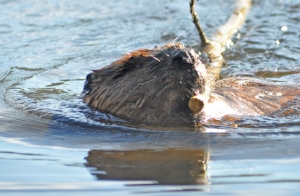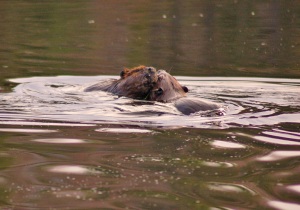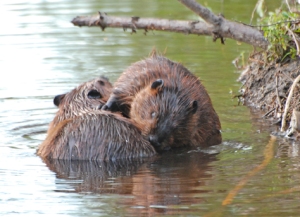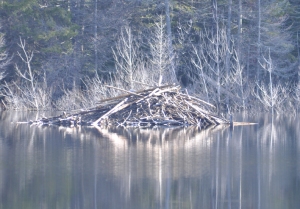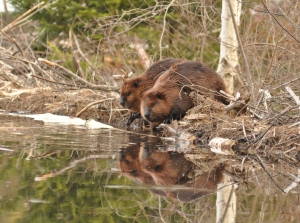What we now refer to as the Beaver Pond was once a mill pond. There was a huge stone dam with a sluice that allowed the miller to control the water level. When he needed to power the mill, he would open the sluice and let water run downstream. In the late 1700s and early 1800s there were seven mills in our town which was then called Mill Village. Two of the mills were on Moose Mountain, a saw mill and a grist mill. There was a wagon road up the mountain and down the other side to enable people from both the towns of Etna, (MIll Village) and Enfield on the East side of Moose Mountain to reach the mills with their logs or grain.
 When the mills were active there were several houses including the miller’s house on Moose Mountain. We still see the cellar holes and stonework when we hike and ski. Other indications of inhabitants are the old apple trees, still producing, huge maple trees and stone walls on either side of the old roads. We found a stone well when we were digging deep for our asparagus patch. Someone must have had a house very close to where we now live. They probably loved the view and sunsets over the valley as much as we do. The mill stream becomes wild when there is a thaw or a heavy rain storm. Many of the mill stones have been washed downstream over the years but the foundations remain.
When the mills were active there were several houses including the miller’s house on Moose Mountain. We still see the cellar holes and stonework when we hike and ski. Other indications of inhabitants are the old apple trees, still producing, huge maple trees and stone walls on either side of the old roads. We found a stone well when we were digging deep for our asparagus patch. Someone must have had a house very close to where we now live. They probably loved the view and sunsets over the valley as much as we do. The mill stream becomes wild when there is a thaw or a heavy rain storm. Many of the mill stones have been washed downstream over the years but the foundations remain.
Now we have resident engineers, beavers, who control the water flow. The sluice has been totally dammed up and there are now six dams between the original one and the road leading to our house. They apply a steady supply of mud, rocks and sticks to strengthen the dams. Their ability to see where work needs to be done is amazing. One wonders how animals as small as they are can accomplish so much. It’s a lesson for all of us. Diligence does pay off. They seem to be able to find time for play, food and work. I do believe they are the Scott and Helen Nearing of the animal world. They never seem to be in a hurry, but very deliberately assessing what needs to be done and then doing it. There does not seem to be a hierarchy among them, they work as a team, sometimes cooperating to move a log that is too heavy for one. The only time I have witnessed aggression in seven years of observing them is over food. They do not share well and first come first serve is the rule. I have occasionally seen real anger over food, but almost always verbal corrections, not physical.
They can be affectionate and frequently participate in grooming each other, letting the other know where to scratch, places that are impossible for them to reach on their own. There is also a ritual called nuzzling when they swim in circles, keeping their heads out of the water and intertwined. The kits do not seem to do this, the parents do. It may be a courtship ritual.

Dam Number Six
When we first moved to Moose Mountain there was an active beaver colony. We found it interesting but were much to busy establishing our business and dealing with five children to pay much attention. We carried on as interested neighbors but when we were most active in the woods during ski season they were under the ice. I am sure now that someone trapped the beavers, because suddenly there were none. We still called it the beaver pond but in reality it was a puddle in the middle of a lush meadow. Moose and deer came to drink water and eat the tall coarse grasses that grew around the edges. Ducks and geese stopped in for a quick visit but never stayed. We enjoyed what wildlife we encountered there and waited for new tenants to arrive.
Eight years ago a lone beaver showed up and stayed for two weeks. I hoped he would decide that this was the right place for him, but he moved on. Little did he know how happy we would be to have him for a neighbor. The next year another young beaver showed up and decided to stay. He was obviously lonely as it was easy to woo him with apples daily. He seemed to enjoy the company and came regularly when I clapped to tell him that the Apple Lady was there. He worked on the dam, increasing the size of the pond quite a bit that first summer. By fall he had built himself a small Lodge in the dam and spent the winter there.
That next spring, he was equally tame and seemed to remember the apple routine. He disappeared in late April and eight days later reappeared with a mate in tow. Of course she knew nothing about apples but quickly learned from him that I was harmless and apples were a treat. They seemed inseparable that first summer together. She insisted on working on the old lodge at the far end of the pond. They nuzzled frequently and sometimes called to one another when they were apart. That was the first time I had heard beaver voices. It was a thrilling experience.
By the time winter arrived they had moved into the lodge and stored a large supply of saplings in the mud beside the lodge. They were set for their first winter on Moose Mountain. I felt reassured that they would keep each other company and survive the winter well together. I did name them,. The male was Bogie and his mate, Elsa. They were easy to tell apart. Bogie was sleek and handsome. Elsa was frumpy. her spikey hair sticking out in all directions. Bogie’s fingernails were long and elegant. Elsa’s were worn down and stubby. They say opposites attract and it was definitely true in their case. They seemed content. There was also the exciting prospect of kits in early summer. I was sad to see the ice close in and isolate them, but they were ready, I was not. I had become beaver obsessed.
 . Another is to alert the other members of the family that there is something at the pond that needs to have their attention. The last and most frequent reason is to practice the slap which is a complicated maneuver requiring an enormous amount of coordination and effort.
. Another is to alert the other members of the family that there is something at the pond that needs to have their attention. The last and most frequent reason is to practice the slap which is a complicated maneuver requiring an enormous amount of coordination and effort.





